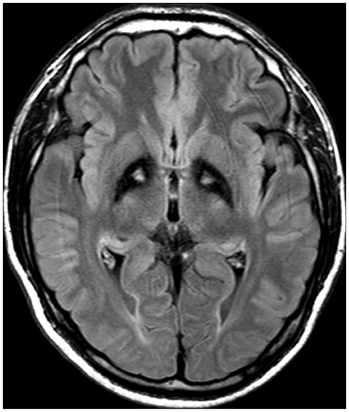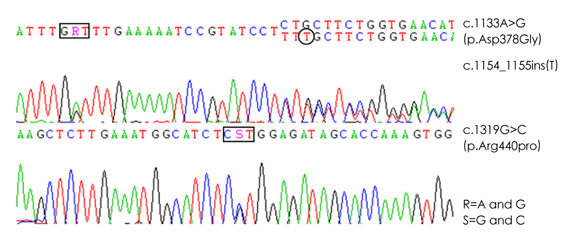J Clin Neurol.
2009 Dec;5(4):192-194. 10.3988/jcn.2009.5.4.192.
A Novel PANK2 Mutation in a Patient with Atypical Pantothenate-Kinase-Associated Neurodegeneration Presenting with Adult-Onset Parkinsonism
- Affiliations
-
- 1Department of Neurology, Yonsei University College of Medicine, Seoul, Korea. phisland@chol.com
- KMID: 2287649
- DOI: http://doi.org/10.3988/jcn.2009.5.4.192
Abstract
- BACKGROUND
Pantothenate-kinase-associated neurodegeneration (PKAN) is an autosomal recessive neurodegenerative disorder that is characterized by progressive extrapyramidal signs, visual loss, and cognitive impairment. PKAN is caused by mutations in the pantothenate kinase gene (PANK2), which is located on chromosome 20p13 and encodes pantothenate kinase, the key regulatory enzyme in coenzyme-A biosynthesis. CASE REPORT: In this report we describe a case of atypical PKAN with a novel PANK2 mutation, presenting with a 10-year history of postural tremor involving both hands. Upon neurological examination, the patient's face was masked and he spoke in a monotonous voice. The patient presented with mild bradykinesia and rigidity that involved all of the extremities. Horizontal saccadic eye movements were slow and fragmented. Brain MRI revealed a typical "eye-of-the-tiger" sign. A mutation analysis revealed three PANK2 mutations: two in exon 3 (Asp 378Gly and Leu385CysfsX13) and one in exon 4 (Arg440Pro). CONCLUSIONS: Parkinsonism is not an unusual presenting symptom in patients with atypical PKAN, and so it is important for physicians to consider PKAN in the differential diagnosis of patients presenting with young-onset parkinsonism.
Keyword
MeSH Terms
Figure
Cited by 1 articles
-
Botulinum Toxin-A Injection in the Treatment of Spasticity in a Infantile-Onset Neurodegeneration With Brain Iron Accumulation: A Case Report
Hwan Kwon Do, Geun Yeol Jo, Jun Koo Kwon, Woo Jin Kim
Ann Rehabil Med. 2018;42(2):363-367. doi: 10.5535/arm.2018.42.2.363.
Reference
-
1. Hayflick SJ, Westaway SK, Levinson B, Zhou B, Johnson MA, Ching KH, et al. Genetic, clinical, and radiographic delineation of Hallervorden-Spatz syndrome. N Engl J Med. 2003. 348:33–40.
Article2. Zhou B, Westaway SK, Levinson B, Johnson MA, Gitschier J, Hayflick SJ. A novel pantothenate kinase gene (PANK2) is defective in Hallervorden-Spatz syndrome. Nat Genet. 2001. 28:345–349.
Article3. Gregory A, Polster BJ, Hayflick SJ. Clinical and genetic delineation of neurodegeneration with brain iron accumulation. J Med Genet. 2009. 46:73–80.
Article4. Thomas M, Hayflick SJ, Jankovic J. Clinical heterogeneity of neurodegeneration with brain iron accumulation (Hallervorden-Spatz syndrome) and pantothenate kinase-associated neurodegeneration. Mov Disord. 2004. 19:36–42.
Article5. Taylor TD, Litt M, Kramer P, Pandolfo M, Angelini L, Nardocci N, et al. Homozygosity mapping of Hallervorden-Spatz syndrome to chromosome 20p12.3-p13. Nat Genet. 1996. 14:479–481.
Article6. Hartig MB, Hörtnagel K, Garavaglia B, Zorzi G, Kmiec T, Klopstock T, et al. Genotypic and phenotypic spectrum of PANK2 mutations in patients with neurodegeneration with brain iron accumulation. Ann Neurol. 2006. 59:248–256.
Article7. Kazek B, Jamroz E, Gencik M, Jezela Stanek A, Marszal E, Wojaczynska-Stanek K. A novel PANK2 gene mutation: clinical and molecular characteristics of patients short communication. J Child Neurol. 2007. 22:1256–1259.
Article8. Antonini A, Goldwurn S, Benti R, Prokisch H, Ebhardt M, Cilia R, et al. Genetic, clinical, and imaging characterization of one patient with late-onset, slowly progressive, pantothenate kinase-associated neurodegeneration. Mov Disord. 2006. 21:417–418.
Article
- Full Text Links
- Actions
-
Cited
- CITED
-
- Close
- Share
- Similar articles
-
- Three Patients With Classic and Atypical Neurodegeneration With Brain Iron Accumulation
- Botulinum Toxin-A Injection in the Treatment of Spasticity in a Infantile-Onset Neurodegeneration With Brain Iron Accumulation: A Case Report
- Treatment of Pantothenate-Kinase Neurodegeneration With Baclofen, Botulinum Toxin, and Deferiprone: A Case Report
- The Case of a Patient with Pantothenate Kinase-Associated Neurodegeneration Presenting with a Prolonged History of Stuttering Speech and a Misdiagnosis of Parkinson’s Disease
- Clinical Heterogeneity of Atypical Pantothenate Kinase-Associated Neurodegeneration in Koreans



